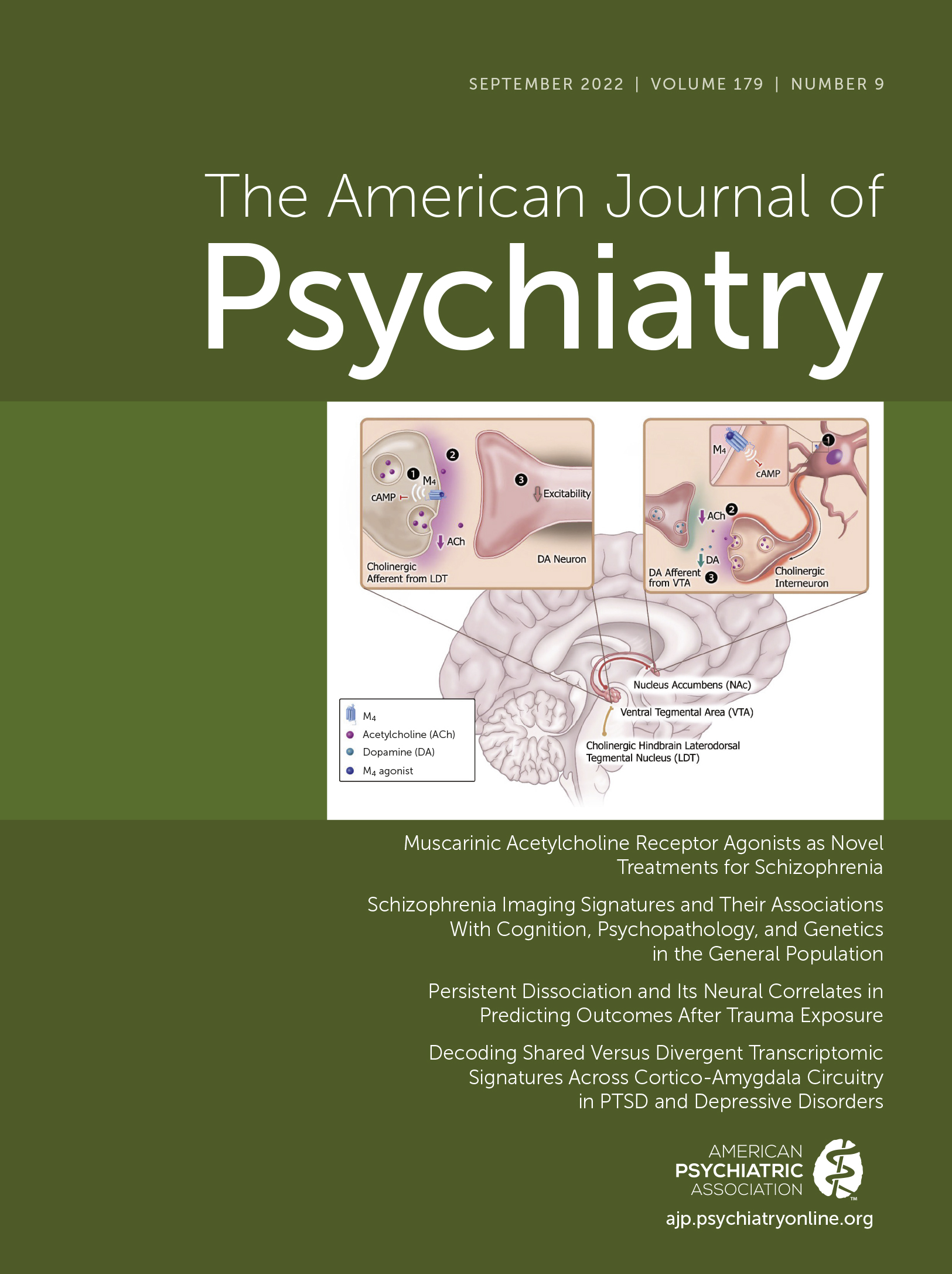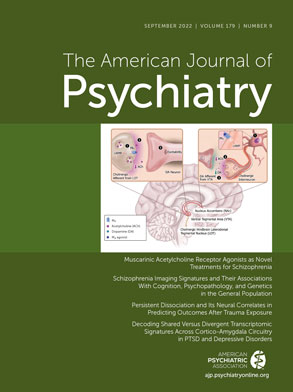Depression and anxiety disorders are the most common mental illnesses. They cluster within families, often co-occur, and cross predict each other (
1–
3). Depression or anxiety in a parent is common and increases the risk for anxiety and depression and other mental health and functional difficulties in biological offspring (
2,
3). Parental anxiety and depression affect large numbers of offspring. For example, a study of health records from England estimated that 26% of children aged 0–16 had a mother with an anxiety disorder or major depressive disorder diagnosed by a health care professional (
4). A separate U.K. study focusing on offspring aged 0–30 reported a higher prevalence, with depression affecting 34.5% of mothers and 18.0% of fathers (
5). Understanding the factors that underlie how anxiety and depression are transmitted within families is therefore important and informs prevention and early intervention strategies, including public health strategy.
To address the question of how anxiety and depression are transmitted within families, genetically informed, family-based designs can separate the relative contribution of genetic and environmental factors to the intergenerational transmission of common mental illness (
6). In this issue, Kendler and colleagues (
7) leverage whole nation anonymous health record data combined with family linkage to create family-based cohorts that can disentangle the causes of phenotypic similarity into those that are due to inherited factors and those that are due to the rearing environment. In a Swedish study comprising over 2 million families, the authors matched offspring and parents to create cohorts of six family types (intact two parent families, not lived with father families, not lived with mother families, stepfather families, stepmother families, and adoptive families) that collectively create an extended adoption study design. By examining the parent-offspring similarity for anxiety disorders (generalized anxiety disorder, panic disorder, anxiety not otherwise specified), major depressive disorder, and across major depressive disorder and anxiety disorders in these family types, the sources of parent-offspring similarity could be attributed to genes, environment, or both. Given the focus on the association between maternal mental illness and offspring outcomes in the literature to date (
4,
8), the inclusion of data from fathers in this large study is an important strength.
Key findings from this study were that there are modest genetic influences on the transmission of anxiety, depression, and the cross transmission of anxiety and depression within families. There was also a smaller but significant contribution of the rearing environment. As an example, for the familial transmission of anxiety, the tetrachoric correlations for the three informative types of family relationship were 0.16 for genes plus rearing, 0.12 for genes only, and 0.06 for rearing only. When decomposing the proportions of the correlations due to genes and environment using the formula in the article’s online supplemental Table 3, 70% was due to genes and 30% due to the rearing environment. Findings were very similar for anxiety and depression, suggesting that these disorders are influenced largely by shared genetic and environmental factors. When looking at the cross transmission of anxiety and depression for separate anxiety disorders (generalized anxiety disorder, panic disorder, and anxiety not otherwise specified), results indicated that common genetic influences with depression were highest for generalized anxiety disorder. Anxiety and depression are often comorbid in an individual and there is no clear consensus on how to deal with comorbidity analytically. The authors used a simple pragmatic approach and used a diagnostic hierarchy (i.e., based on available information making a best guess diagnosis of either anxiety or depression as the primary diagnosis). Using this approach, the influence of common genetic factors on anxiety and depression was lower. The focus on diagnosed disorders from health records means that the results of the present study apply to those with anxiety and depressive disorder who seek assessment and intervention. The inclusion of health records from primary care (where the majority of common mental illness is treated) (
9) is a strength. Nevertheless, some cases will be missed because many more individuals are affected by anxiety and depressive disorder than seek treatment.
As with all good studies, the findings here raise some specific questions and suggest some possible questions for future studies to examine. First, it is interesting to speculate on what the effects of the rearing environment reflect. Genetically informed studies assess the effect of the environment on phenotypic similarity between parent-offspring pairs and for that reason are not usually informative about what the likely environmental
processes or causal effects are. What can we glean from observational and quasi-experimental studies to inform us on what the likely potential causal processes at play might be? It seems likely that there are some common sets of social determinants that affect anxiety and depression in both the parent and offspring generation. These may include factors such as poverty, socioeconomic inequalities, and family stressors, given evidence supporting the causal role of poverty and stressful events on anxiety and depression (
10,
11) coupled with observations that rates of parental anxiety and depression are elevated in more economically deprived areas (
4) and are associated with familial stressors (
12). There are also likely to be direct influences of parental behavior and the environment that parents create for their children with parenting behavior and family stress both implicated in the intergenerational transmission of anxiety and depression (
12). Finally, while it is usually assumed that risk for parental mental illness is transmitted to offspring, the possibility of bidirectional effects where offspring mental health problems have an impact on parents as well as parental mental health influencing child mental health cannot be ruled out. Such effects have been reported where, for instance, in a longitudinal study, child depressive symptoms were associated with a later increase in maternal depressive symptoms (
13).
Other thought-provoking questions raised by this study are of the relative importance of maternal and paternal influences on offspring anxiety and depression and the possibility of developmental differences based on offspring developmental stage or age. Observational studies of the offspring of parents (usually mothers) with anxiety and/or depression have described a variety of differences compared to healthy control groups in infants, children, teenagers, and adults. How might the developmental stage of offspring affect factors involved in the intergenerational transmission of anxiety and depression? While the estimates of genes only and rearing environment only did not differ according to whether the mother or father was affected, the estimate of the combined contribution of genes plus the rearing environment (i.e., parent-offspring similarity from pairs in biologically related families) was consistently slightly stronger for mother-offspring pairs than for father-offspring pairs. It is unclear what is driving this effect, but stronger associations between maternal-offspring transmission for anxiety and depression have been reported in other studies including those using genetically sensitive designs (
8,
14). Previous studies have speculated that stronger maternal-offspring similarity may be partly due to the greater role mothers have for caregiving even in two parent families. However, in the current paper by Kendler and colleagues, adult offspring were aged between 26 and 58 years, which suggests that sets of factors relevant to adult life may play a role, potentially including maternal influences on offspring help-seeking behavior given the focus on diagnoses made by a health care professional in this study. The next point is the possibility of age-related differences in the contribution of the rearing environment. Genetically informed studies of younger offspring, living in the parental family home, consistently find that the contribution of the rearing environment predominates in associations between anxiety and depressive symptoms (
14,
15). A sensitivity analysis in the current paper involved examining the younger (aged 26–42) and the older (aged 43–58) halves of the cohort and found consistent evidence for stronger genes plus rearing environment in the younger cohort. As noted by the authors, such differences may be due to several factors, but they do highlight the potential importance of future studies focused on understanding developmental differences in the intergenerational transmission of anxiety and depression symptoms and disorders depending on the age of offspring.
There are some subtle differences in the pattern of findings from the current study compared with those from twin design studies which, as noted by the authors, is at least partly due to differences in the research designs. Twin studies involve comparing siblings (identical and nonidentical) of exactly the same age, whereas adoption designs and their extensions involve comparing parent and offspring pairs whose relatedness varies (e.g., intact families vs. stepparent families or adoptive families). Adoption studies therefore have a greater ability to detect effects of the rearing environment. A strength of adoption studies is that for some parent-offspring pairs, passive gene-environment correlation—a phenomenon that comes about because of the influence of parental genotype on the rearing environment—is removed. However, a limitation is that there may be qualitative differences in parenting and parent-child processes based on family type.
In summary, the present large study uses a novel extended adoption study design to highlight that there are shared genetic and rearing environment influences on anxiety and depression. Important future work involves understanding effective ways of interrupting the intergenerational cycle of transmission of anxiety and depression, ensuring optimization of treatment for parents with anxiety and depression, and implementing calls for improved access to prevention and early intervention programs for young people affected by parental mental illness (
16).

